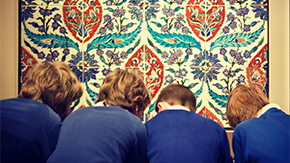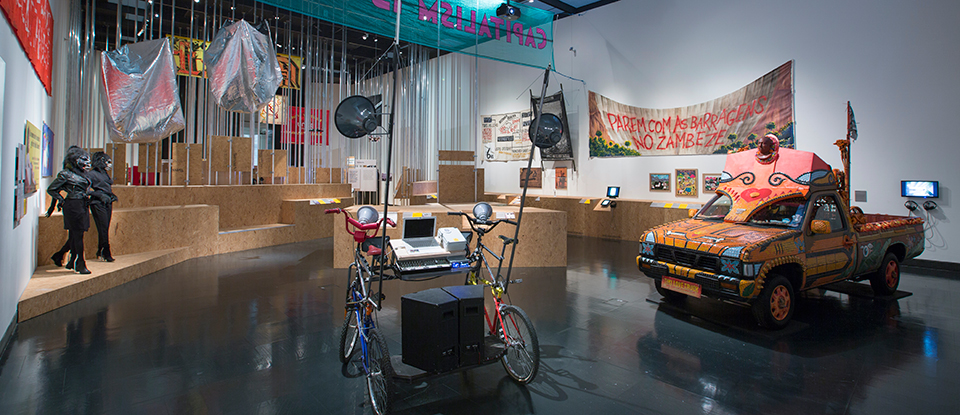An artwork designed by Zaher Omareen and Ibrahim Fakhri was commissioned feature as part of the V&A exhibition Disobedient Objects. The two artists discuss the background and process of the artwork which documents some of the individuals lost in the Syrian revolution. The piece was created using stencils and spray painted directly onto the gallery wall. Similar stencils have been shared online to encourage people to repeat them on walls around the world as they have done and continue to in Syria. The text in the artwork reads ‘Freedom'
Zaher Omareen and Ibrahim Fakhri: We’re trying to document the martyrs, the people we lost in the revolution. It first started with them saying on the news, like, today we’ve lost twenty Syrians, thirty Syrians, five-hundred Syrians, and so on. And that’s it, numbers basically. We wanted to do a bit more; they’re not numbers, they’re humans, they’re people really, just like you and I.
We’ve tried to collect a few of the faces, we’ve done faces from different phases of our revolution. Just to, you know, tell a story here. Those people were here and they got killed for going to the bakery, for going to school, for doing nothing at all, for going out to demonstrations, you know asking for their freedom, and they’re gone, we’re here. Nobody knows their names, nobody knows their faces. That’s why we came.
Whenever you get a chance to spray those nice stencils, anyway you’ll just pray somebody will come and hide it, cover it, or even worse you might get shot, er, on the spot really, like…
…one of the guys, the third guy up there on top, they call him ‘The Spray Man’. He was shot while spraying and he designed huge stencils for his friends, he designed lots of the calligraphy that goes with the stencils and he was just shot doing it. It’s Syria; you can’t just go out and say what you want to say. They won’t let you. That’s why the revolution is still there. Er, freedom of speech is nothing that we dream of so once the revolution started we tried to say that. We went out to demonstrations, at demonstrations they shot us, so we had still to say something. So I started writing on the walls.
Freedom: that’s the key word for the whole revolution thing. That’s the first demonstration. People want their freedom. That’s it. And wherever you go now, anywhere in the streets in Damascus, the other streets, outside the mosque, the other cities – the cities are at the control of the regime. That’s where you’ll find it everywhere; faces of the people that are gone. Art demands freedom, dignity. It’s a high security zone now so there are checkpoints everywhere. So you can’t just sneak your tools in, you can’t just, you know, paint a face on the wall, you have to have a stencil for it. So they started coming up with those amazing ideas of, er, tools. They conceal a stencil made out of newspaper within a newspaper, spray it on the wall, jump in, run. Then use extra issues - those are the easiest materials to cut really – and they’re easy to fold or wrap and also to conceal in other documents. So also they use paper bags, shopping bags, boxes of their tools… Er, that’s it really. They don’t always use sprays, they could use any other materials…a shoe polish…a, you know, school colours, anything, really. That’s the stuff we’re trying to show, just typically how it’s done. It’s not exactly sophisticated. They don’t get ant time drawing on fancy materials; it’s a newspaper, it’s a paper bag.
You walk in the street now in England, anywhere in Europe really, and the World – you think there’s a conflict going on. There’s a sort of dispute, a civil war even, then nobody knows what’s happening. Nobody knows the real story. It’s as simple as people demanding their rights. What happened if they did? They got shot. Nobody knew their names. I want people to come here, realise those faces, they used to be there. They were tortured to death, they were shot on the spot, there are children amongst those guys. They were just killed for no real reason. I’m going to have their names there. I’m going to try to have a brief story about them. They need to be acknowledged. Those people dying every day - dying now as we speak – they need to be acknowledged. They’re not numbers, they’re humans.


